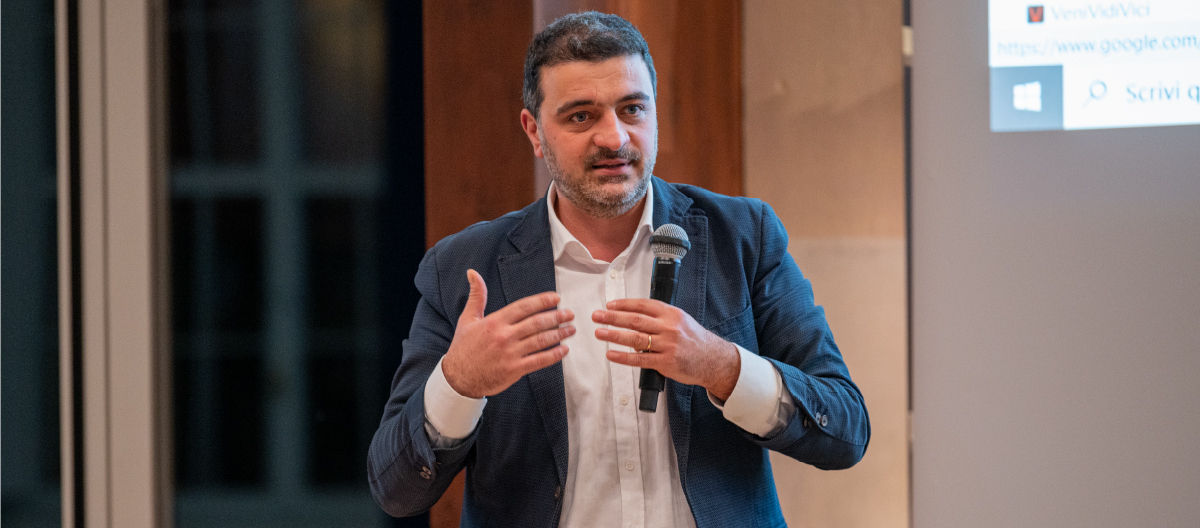
Leadership Talk | Lorenzo Balbi, Director at MAMbo
6 February 2023A unique Leadership Talk was dedicated to the city of Bologna, art, and its significance in everyone’s lives, regardless of one’s field of study or career.
The occasion to discuss art and inspire BBS MBA participants to explore Bologna’s rich artistic heritage was the just-concluded 11th edition of Art City Bologna 2023, two weeks filled with free events, exhibitions, and initiatives. Lorenzo Balbi, Director of MAMbo Museum of Modern Art in Bologna, directed the event for the sixth year. He was a guest of Marcello Russo, Director of the Global MBA, who acted as host at Villa Guastavillani.
Russo was impressed to learn that many American degree courses, including Medicine and Business Management, include art courses. The director of these courses emphasized the importance of fostering lateral thinking by exposing students to something beautiful and distinct from conventional subjects. This led to the decision to encourage Bologna Business School students from all over the world to discover the artistic wealth of Italy and Bologna.”
What better way to do this than by inviting Lorenzo Balbi himself? The Director presented the Museum and the initiative. He told how attention towards modern art in a city like Bologna, with a solid creative and innovative spirit, is born, grows, and nourishes. The Museum, founded in 1975, started from this point: a long period of experimentation, mixing the permanent collection and temporary exhibitions, since the construction of the Museum’s second building, which would have allowed separating the two things, was never completed. This experimental vocation, combined with being at the centre of a new artistic phenomenon, allowed the Museum to host in 1994 the first exhibition in Italy dedicated to street writing and graffiti art. It was shocking for the time: graffiti art was not considered museum art. Indeed, someone did not even consider it art but rather vandalism. It was also the first time Italian street artists could work directly inside the Museum, thanks to a temporary show dedicated to them. And it was not even the first time the Museum distinguished itself in Italy for its audacity. At the end of the seventies, it hosted the International Week of Performance. Marina Abramovic was just beginning, and this type of art was not understood by everyone, much less by a conservative environment like that of Italian art. It was 1977, and the now famous Abramovic talked about herself and her then partner Ulay, with the performance Imponderabilia. “Today we talk about an art superstar,” Balbi explained, “but at the time, the police arrived because the performance required the two to be naked facing each other.” This vocation for the fearless dissemination of new creative languages must naturally be nourished. In this, Bologna was also brave in terms of Fairs, being one of the first cities to propose a fair dedicated to the modern art market.
Balbi then told the students how Art City was born and developed, explaining in detail the most exciting elements of the programme. These included the performance Have a Nice Day, by a group of Lithuanian authors who created an opera from the phrases uttered every day by supermarket cashiers. Or like Yuri Ancarani’s Atlantis, a metaphor for life and growth, and Roberto Fassone’s And We Thought III, which works with artificial intelligence, testing it in doing absurd things, like eating hallucinogenic mushrooms, to experiment with new artistic languages. Theatres, cinemas, museums, streets… Bologna came alive during Art City in various locations to involve its citizens as much as possible.
“The idea is not to focus on specific events, but to have many events scattered around the city so that people can walk around and always find something open and free,” said Balbi. “Even better if it’s not a place where you would expect to find art, like museums or private galleries, if we can open up unusual spaces or spaces that are normally closed and do it through the languages and works of artists.”
Art City 2023 has come to an end. While waiting for the next edition, the invitation is to open up to the artistic wonders of the city. These are not only the oldest ones but also the modern and contemporary, unexpected and experimental ones, to be discovered on the walls and in city locations such as MAMbo.
